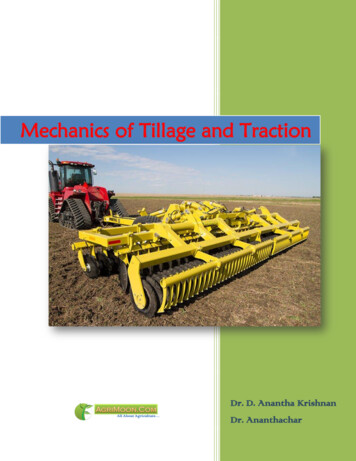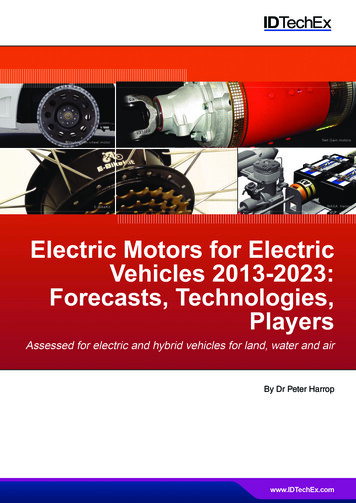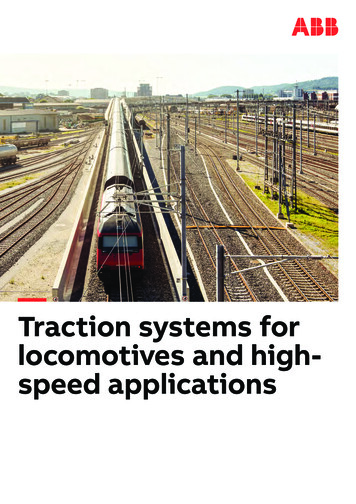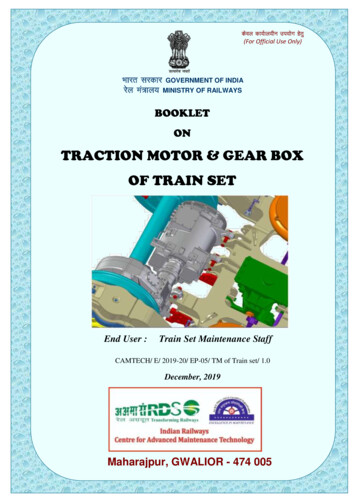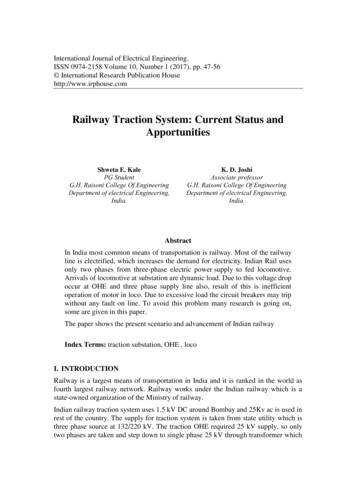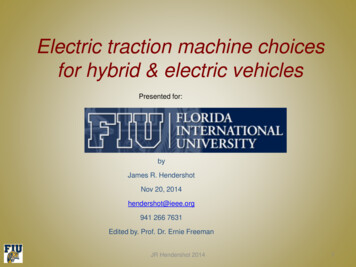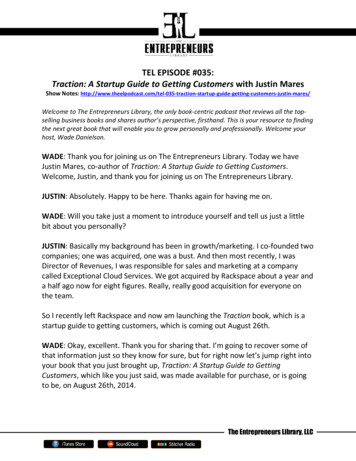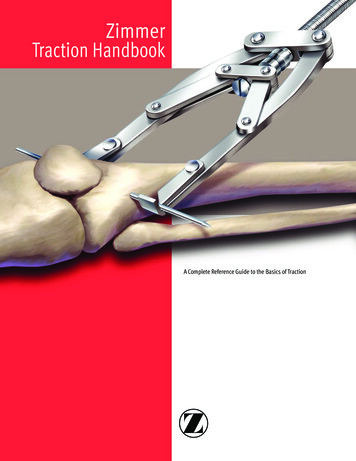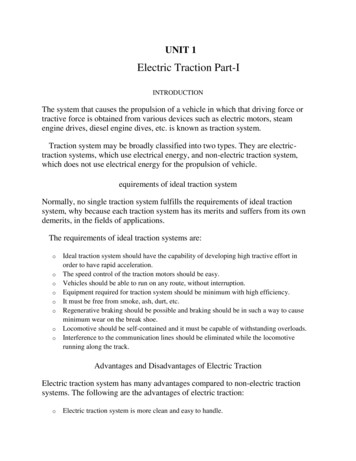
Transcription
UNIT 1Electric Traction Part-IINTRODUCTIONThe system that causes the propulsion of a vehicle in which that driving force ortractive force is obtained from various devices such as electric motors, steamengine drives, diesel engine dives, etc. is known as traction system.Traction system may be broadly classified into two types. They are electrictraction systems, which use electrical energy, and non-electric traction system,which does not use electrical energy for the propulsion of vehicle.equirements of ideal traction systemNormally, no single traction system fulfills the requirements of ideal tractionsystem, why because each traction system has its merits and suffers from its owndemerits, in the fields of applications.The requirements of ideal traction systems are:ooooooooIdeal traction system should have the capability of developing high tractive effort inorder to have rapid acceleration.The speed control of the traction motors should be easy.Vehicles should be able to run on any route, without interruption.Equipment required for traction system should be minimum with high efficiency.It must be free from smoke, ash, durt, etc.Regenerative braking should be possible and braking should be in such a way to causeminimum wear on the break shoe.Locomotive should be self-contained and it must be capable of withstanding overloads.Interference to the communication lines should be eliminated while the locomotiverunning along the track.Advantages and Disadvantages of Electric TractionElectric traction system has many advantages compared to non-electric tractionsystems. The following are the advantages of electric traction:oElectric traction system is more clean and easy to handle.
oooooooNo need of storage of coal and water that in turn reduces the maintenance cost as wellas the saving of high-grade coal.Electric energy drawn from the supply distribution system is sufficient to maintain thecommon necessities of locomotives such as fans and lights; therefore, there is no needof providing additional generators.The maintenance and running costs are comparatively low.The speed control of the electric motor is easy.Regenerative braking is possible so that the energy can be fed back to the supplysystem during the braking period.In electric traction system, in addition to the mechanical braking, electrical braking canalso be used that reduces the wear on the brake shoes, wheels, etc.Electrically operated vehicles can withstand for overloads, as the system is capable ofdrawing more energy from the system.In addition to the above advantages, the electric traction system suffers from thefollowing drawbacks:oooooElectric traction system involves high erection cost of power system.Interference causes to the communication lines due to the overhead distributionnetworks.The failure of power supply brings whole traction system to stand still.In an electric traction system, the electrically operated vehicles have to move only onthe electrified routes.Additional equipment should be needed for the provision of regenerative braking, itwill increase the overall cost of installation.REVIEW OF EXISTING ELECTRIC TRACTION SYSTEM IN INDIAIn olden days, first traction system was introduced by Britain in 1890 (600-V DCtrack). Electrification system was employed for the first traction vehicle. Thistraction system was introduced in India in the year 1925 and the first tractionsystem employed in India was from Bombay VT to Igatpuri and Pune, with 1,500V DC supply. This DC supply can be obtained for traction from substationsequipped with rotary converters. Development in the rectifiers leads to thereplacement of rotary converters by mercury arc rectifiers. But nowadays furtherdevelopment in the technology of semiconductors, these mercury arc valves arereplaced by solid-state semiconductors devices due to fast traction system wasintroduced on 3,000-V DC. Further development in research on traction system byFrench international railways was suggested that, based on relative merits and
demerits, it is advantageous to prefer to AC rather than DC both financially andoperationally.Thus, Indian railways was introduced on 52-kV, 50-Hz single-phase AC systemin 1957; this system of track electrification leads to the reduction of the cost ofoverhead, locomotive equipment, etc. Various systems employed for trackelectrification are shown in Table .Table Track electrification systemsSYSTEM OF TRACTIONTraction system is normally classified into two types based on the type of energygiven as input to drive the system and they are:1.Non-electric traction systemTraction system develops the necessary propelling torque, which do notinvolve the use of electrical energy at any stage to drive the tractionvehicle known as electric traction system.Ex: Direct steam engine drive and direct internal combustion enginedrive.2.Electric traction systemTraction system develops the necessary propelling torque, which involvesthe use of electrical energy at any stage to drive the traction vehicle,known as electric traction system.Based upon the type of sources used to feed electric supply for tractionsystem, electric traction may be classified into two groups:1.2.Self-contained locomotives.Electric vehicle fed from the distribution networks.
Self-contained locomotivesIn this type, the locomotives or vehicles themselves having a capability ofgenerating electrical energy for traction purpose. Examples for such type oflocomotives are:1. Steam electric driveIn steam electric locomotives, the steam turbine is employed for driving agenerator used to feed the electric motors. Such types of locomotives arenot generally used for traction because of some mechanical difficulties andmaintenance problems.2. Diesel electric trainsA few locomotives employing diesel engine coupled to DC generator usedto feed the electric motors producing necessary propelling torque. Dieselengine is a variable high-speed type that feeds the self- or separatelyexcited DC generator. The excitation for generator can be supplied fromany auxiliary devices and battery.Generally, this type of traction system is suggested in the areas wherecoal and steam tractions are not available. The advantages anddisadvantages of the diesel engine drive are given below:AdvantagesooooooAs these are no overhead distribution system, initial cost is low.Easy speed control is possible.Power loss in speed control is very lowTime taken to bring the locomotive into service is less.In this system, high acceleration and braking retardation can be obtained compared tosteam locomotives.The overall efficiency is high compared to steam locomotives.DisadvantagesoooThe overloading capability of the diesel engine is less.The running and maintenance costs are high.The regenerative braking cannot be employed for the diesel engine drives.Petrol electric tractionThis system of traction is used in road vehicles such as heavy lorries and buses.These vehicles are capable of handling overloads. At the same time, this system
provides fine and smooth control so that they can run along roads without anyjerking.Battery drivesIn this drive, the locomotive consists of batteries used to supply power to DCmotors employed for driving the vehicle. This type of drives can be preferred forfrequently operated services such as local delivery goods traction in industrialworks and mines, etc. This is due to the unreliability of supply source to feed theelectric motors.Electric vehicles fed from distribution networkVehicles in electrical traction system that receives power from over headdistribution network fed or substations with suitable spacing. Based on theavailable supply, these groups of vehicles are further subdivided into:1. System operating with DC supply. Ex: tramways, trolley buses, and railways.2. System operating with AC supply. Ex: railways.Systems operating with DC supplyIn case if the available supply is DC, then the necessary propelling power can beobtained for the vehicles from DC system such as tram ways, trolley buses, andrailways.Tramways: Tramways are similar to the ordinary buses and cars but only thedifference is they are able to run only along the track. Operating power supply forthe tramways is 500-V DC tramways are fed from single overhead conductor actsas positive polarity that is fed at suitable points from either power station orsubstations and the track rail acts as return conductor.The equipment used in tramways is similar to that used in railways but withsmall output not more than 40–50 kW. Usually, the tramways are provided withtwo driving axels to control the speed of the vehicles from either ends. The maindrawback of tramways is they have to run along the guided routes only. Rehostaticand mechanical brakings can be applied to tramways. Mechanical brakes can beapplied at low speeds for providing better saturation where electric braking isineffective, during the normal service. The erection and maintenance costs oftramways are high since the cost of overhead distribution structure is costlier andsometimes, it may cause a source of danger to other road users.
Trolley buses: The main drawback of tramways is, running along the track isavoided in case of trolley buses. These are electrically operated vehicles, and arefed usually 600-V DC from two overhead conductors, by means of two collectors.Even though overhead distribution structure is costlier, the trolley buses areadvantageous because, they eliminate the necessity of track in the roadways.In case of trolley buses, rehostatic braking is employed, due to high adhesionbetween roads and rubber types. A DC compound motor is employed in trolleybuses.SYSTEM OF TRACK ELECTRIFICATIONNowaday, based on the available supply, the track electrification system arecategorized into.1.DC system.2. Single-phase AC system.3. Three-phase AC system.4. Composite system.1 DC systemIn this system of traction, the electric motors employed for getting necessarypropelling torque should be selected in such a way that they should be able tooperate on DC supply. Examples for such vehicles operating based on DC systemare tramways and trolley buses. Usually, DC series motors are preferred fortramways and trolley buses even though DC compound motors are available whereregenerative braking is desired. The operating voltages of vehicles for DC trackelectrification system are 600, 750, 1,500, and 3,000 V. Direct current at 600–750V is universally employed for tramways in the urban areas and for many suburbanand main line railways, 1,500–3,000 V is used. In some cases, DC supply fortraction motor can be obtained from substations equipped with rotary converters toconvert AC power to DC. These substations receive AC power from 3-φ highvoltage line or single-phase overhead distribution network. The operating voltagefor traction purpose can be justified by the spacing between stations and the type oftraction motors available. Theses substations are usually automatic and remotecontrolled and they are so costlier since they involve rotary converting equipment.The DC system is preferred for suburban services and road transport where stopsare frequent and distance between the stops is small.
2 Single-phase AC systemIn this system of track electrification, usually AC series motors are used for gettingthe necessary propelling power. The distribution network employed for suchtraction systems is normally 15–25 kV at reduced frequency of 163⅔ Hz or 25 Hz.The main reason of operating at reduced frequencies is AC series motors that aremore efficient and show better performance at low frequency. These high voltagesare stepped down to suitable low voltage of 300–400 V by means of step-downtransformer. Low frequency can be obtained from normal supply frequency withthe help of frequency converter. Low-frequency operation of overheadtransmission line reduces the line reactance and hence the voltage drops directlyand single-phase AC system is mainly preferred for main line services where thecost of overhead structure is not much importance moreover rapid acceleration andretardation is not required for suburban services.3 Three-phase AC systemIn this system of track electrification, 3-φ induction motors are employed forgetting the necessary propelling power. The operating voltage of induction motorsis normally 3,000–3,600-V AC at either normal supply frequency or 16⅔-Hzfrequency.Usually 3-φ induction motors are preferable because they have simple and robustconstruction, high operating efficiency, provision of regenerative braking withoutplacing any additional equipment, and better performance at both normal andseduced frequencies. In addition to the above advantages, the induction motorssuffer from some drawbacks; they are low-starting torque, high-starting current,and the absence of speed control. The main disadvantage of such trackelectrification system is high cost of overhead distribution structure. Thisdistribution system consists of two overhead wires and track rail for the third phaseand receives power either directly from the generating station or throughtransformer substation.Three-phase AC system is mainly adopted for the services where the outputpower required is high and regeneration of electrical energy is possible.4 Composite systemAs the above track electrification system have their own merits and demerits, 1φ AC system is preferable in the view of distribution cost and distribution voltage
can be stepped up to high voltage with the use of transformers, which reduces thetransmission losses. Whereas in DC system, DC series motors have most desirablefeatures and for 3-φ system, 3-φ induction motor has the advantage of automaticregenerative braking. So, it is necessary to combine the advantages of the DC/ACand 3-φ/1-φ systems. The above cause leads to the evolution of composite system.Composite systems are of two types.1.Single-phase to DC system.2. Single-phase to three-phase system or kando system.Single-phase to DC systemIn this system, the advantages of both 1-φ and DC systems are combined to gethigh voltage for distribution in order to reduce the losses that can be achieved with1-φ distribution networks, and DC series motor is employed for producing thenecessary propelling torque. Finally, 1-φ AC distribution network results minimumcost with high transmission efficiency and DC series motor is ideally suited fortraction purpose. Normal operating voltage employed of distribution is 25 kV atnormal frequency of 50 Hz. This track electrification is employed in India.Single-phase to 3-φ system or kando systemIn this system, 1-φ AC system is preferred for distribution network. Since singlephase overhead distribution system is cheap and 3-φ induction motors areemployed as traction motor because of their simple, robust construction, and theprovision of automatic regenerative braking.The voltage used for the distribution network is about 15–25 kV at 50 Hz. This1-φ supply is converted to 3-φ supply through the help of the phase converters andhigh voltage is stepped down transformers to feed the 3-φ induction motors.Frequency converters are also employed to get high-starting torque and to achievebetter speed control with the variable supply frequency.SPECIAL FEATURES OF TRACTION MOTORSThe general features of the electric motors used for traction purpose are:1. Mechanical features.2. Electrical features.
Mechanical features1. A traction motor must be mechanically strong and robust and it should be capable ofwithstanding severe mechanical vibrations.2. The traction motor should be completely enclosed type when placed beneath thelocomotive to protect against dirt, dust, mud, etc.3. In overall dimensions, the traction motor must have small diameter, to arrange easilybeneath the motor coach.4. A traction motor must have minimum weight so the weight of locomotive willdecrease. Hence, the load carrying capability of the motor will increase.Electrical featuresHigh-starting torqueA traction motor must have high-starting torque, which is required to start themotor on load during the starting conditions in urban and suburban services.Speed controlThe speed control of the traction motor must be simple and easy. This is necessaryfor the frequent starting and stopping of the motor in traction purpose.Dynamic and regenerative brakingTraction motors should be able to provide easy simple rehostatic and regenerativebraking subjected to higher voltages so that system must have the capability ofwithstanding voltage fluctuations.TemperatureThe traction motor should have the capability of withstanding high temperaturesduring transient conditions.Overload capacityThe traction motor should have the capability of handling excessecive overloads.
Parallel runningIn traction work, more number of motors need to run in parallel to carry more load.Therefore, the traction motor should have such speed–torque and current–torquecharacteristics and those motors may share the total load almost equally.CommutationTraction motor should have the feature of better commutation, to avoid thesparking at the brushes and commutator segments.TRACTION MOTORSNo single motor can have all the electrical operating features required for traction.In earlier days, DC motor is suited for traction because of the high-startingtorque and having the capability of handling overloads. In addition to the abovecharacteristics, the speed control of the DC motor is very complicated throughsemiconductor switches. So that, the motor must be designed for high base speedinitially by reducing the number of turns in the field winding. But this willdecrease the torque developed per ampere at the time of staring. And regenerativebraking is also complicated in DC series motor; so that, the separately excitedmotors can be preferred over the series motor because their speed control ispossible through semi-controlled converters. And also dynamic and regenerativebraking in separately excited DC motor is simple and efficient.DC compound motors are also preferred for traction applications since it ishaving advantageous features than series and separately excited motors.But nowadays squirrel cage induction and synchronous motors are widely usedfor traction because of the availability of reliable variable frequency semiconductorinverters.The squirrel cage induction motor has several advantages over the DC motors.They are:1.Robust construction.2. Highly reliable.3. Low maintenance and low cost.4. High efficiency.
Synchronous motor features lie in between the squirrel cage induction motor andthe DC motor. The main advantages of the synchronous motor over the squirrelcage induction motor are:1.The synchronous motors can be operated at leading power by varying the fieldexcitation.2. Load commutated thyristor inverter is used in synchronous motors as compared toforced commutation thyristor inverter in squirrel cage induction motors.Even though such forced commutation reduces the weight and volume of inductionmotor, the synchronous motor is less expensive.1. DC series motorFrom the construction and operating characteristics of the DC series motor, it iswidely suitable for traction purpose. Following features of series motor make itsuitable for traction.1.DC series motor is having high-starting torque and having the capability of handlingoverloads that is essential for traction drives.2. These motors are having simple and robust construction.3. The speed control of the series motor is easy by series parallel control.4. Sparkless commutation is possible, because the increase in armature current increasesthe load torque and decreases the speed so that the emf induced in the coils undergoingcommutation.5. Series motor flux is proportional to armature current and torque. But armature currentis independent of voltage fluctuations. Hence, the motor is unaffected by the variationsin supply voltage.6. We know that:But the power output of the motor is proportional to the product of torqueand speed. Motor output
That is motor input drawn from the source is proportional to the squareroot of the torque. Hence, the series motor is having self-retainingproperty.7.If more than one motor are to be run in parallel, their speed–torque and current–torquecharacteristics must not have wide variation, which may result in the unequal wear of drivingwheels.2 DC shunt motorFrom the characteristics of DC shunt motor, it is not suitable for traction purpose,due to the following reasons:1. DC shunt motor is a constant speed motor but for traction purpose, the speed of themotor should vary with service conditions.2. In case of DC shunt motor, the power output is independent of speed and isproportional to torque. In case of DC series motor, the power output is proportionaltoSo that, for a given load torque, the shunt motor has to draw more power fromthe supply than series motor.3. For shunt motor, the torque developed is proportional to armature current (T Ia). Sofor a given load torque motor has to draw more current from the supply.4. The flux developed by shunt motor is proportional to shunt field current and hencesupply voltage. But the torque developed is proportionalto φsh and Ia. Hence, the torque developed by the shunt motor is affected by smallvariations in supply voltage.5. If two shunt motors are running in parallel, their speed–torque and speed–currentcharacteristics must be flat and same. Otherwise, the currents drawn by the motor fromthe supply mains will be different and cause to unequal sharing of load.Example 9.1: A DC series motor drives a load. The motor takes a current of 13 Aand the speed is 620 rpm. The torque of the motor varies as the square of speed.The field winding is shunted by a diverter of the same resistance as that of the fieldwinding, then determine the motor speed and current. Neglect all motor losses andassume that the magnetic circuit is unsaturated.Solution:Before connecting field diverter:Speed, N1 620 rpm.
Series field current, Ise1 13 A.The same current flows through the armature; so that,I1 Isel Ia1 13 A.After connecting field diverter, the field winding is shunted by the diverter of thesame refinance; so that:Series field current.Since torque developed:According to given data, the torque varies as the square of the speed.From Equations (i) and (ii):
All the losses are neglected, and assume that the supply voltage is constant.From Equations (iii) and (iv):From Equation (iv):
Example: A series motor having a resistance of 0.8 Ω between its terminaldrives. The torque of a fan is proportional to the square of the speed. At 220 V, itsspeed is 350 rpm and takes 12 A. The speed of the fan is to be raised to 400 rpm bysupply voltage control. Estimate the supply voltage required.Solution:Ra Rse 0.8 Ω, V1 220 V, N1 350 rpm, I1 Ia1 12 AN2 400 rpm.Use the torque equation,Also T N2 (given)Equating Equations (i) & (ii):
Use the speed equationNow, Eb1 V1- Ia1(Ra Rse) 220 – 12(0.8) 210.4 V.In second case, the voltage is to be changed from V1 to V2. Eb2 V2 - Ia2(Ra Rse) V2 – 13.7(0.8) V2 – 10.96.Eb1 and Eb2 are substituted in Eq (iii): This is the new supply voltage required to raise the speed from 350 rpm to 400rpm.Example: A 230-V DC shunt motor takes a current of 20 A on a certain load. Thearmature resistance is 0.8 Ω and the field circuit resistance is 250 Ω. Find theresistance to be inserted in series with the armature to have the speed is half if theload torque is constant.Solution:IL1 20 A.
Ia1 IL1 – Ish 20 – 0.92 19.08.Eb1 V – Ia1Ra 230 – 19.08(0.08) 214.736 V.T φIa Ia( φ is constant).as torque is constant Ia1 Ia2 19.08A.Rx external resistance in armatureEb2 V – Ia2(Ra Rx 230 – (19.08)(0.8 Rx).AC series motorPractically, AC series motor is best suited for the traction purpose due to highstarting torque (Fig. 9.1). When DC series motor is fed from AC supply, it worksbut not satisfactorily due to some of the following reasons:1.If DC series motor is fed from AC supply, both the field and the armature currentsreverse for every half cycle. Hence, unidirectional torque is developed at double frequency.
2. Alternating flux developed by the field winding causes excessive eddy current loss,which will cause the heating of the motor. Hence, the operating efficiency of the motorwill decrease.3. Field winding inductance will result abnormal voltage drop and low power factor thatleads to the poor performance of the motor.4. Induced emf and currents flowing through the armature coils undergoing commutationwill cause sparking at the brushes and commutator segments.Fig. AC series motorHence, some modifications are necessary for the satisfactory operation of the DCseries motor on the AC supply and they are as follows:1.In order to reduce the inductive reactance of the series field, the field winding of ACseries motor must be designed for few turns.2. The decrease in the number of turns of the field winding reduces the load torque, i.e., iffield turns decrease, its mmf decrease and then flux, which will increase the speed, andhence the torque will decrease. But in order to maintain constant load torque, it isnecessary to increase the armature turns proportionately.3. If the armature turns increase, the inductive reactance of the armature would increase,which can be neutralized by providing the compensating winding.4. Magnetic circuit of an AC series motor should be laminated to reduce eddy currentlosses.5. Series motor should be operating at low voltage because high voltage low currentsupply would require large number of turns to produce given flux.
6. Motor should be operating at low frequency, because inductive reactance isproportional to the frequency. So, at low frequency, the inductive reactance of the fieldwinding decreases.The operating characteristics of the AC series motor are similar to the DC seriesmotor. Weight of an AC series motor is one and a half to two times that of a DCseries motor. And operating voltage is limited to 300 V. They can be built up to thesize of several hundred kW for traction work.At the time of starting operation, the power factor is low; so that, for a givencurrent, the torque developed by the AC motor is less compared to the DC motor.Thus, the AC series motor is not suitable for suburban services with frequent stopsand preferred for main line service where high acceleration is not required.Three-phase induction motorThe three-phase induction motors are generally preferred for traction purpose dueto the following advantages.1.2.3.4.5.6.Simple and robust construction.Trouble-free operation.The absence of commutator.Less maintenance.Simple and automatic regeneration.High efficiency.Three-phase induction motor also suffer from the following drawbacks.1. Low-starting torque.2. High-starting current and complicated speed control system.3. It is difficult to employ three-phase induction motor for a multiple-unit system used forpropelling a heavy train.Three-phase induction motor draws less current when the motor is started at lowfrequencies. When a three-phase induction motor is used, the cost of overheaddistribution system increases and it consists of two overhead conductors and trackrail for the third phase to feed power to locomotive, which is a complicatedoverhead structure and if any person comes in contact with the third rail, it maycause danger to him or her.
This drawback can be overcome by employing kando system. In this system, 1φ supply from the overhead distribution structure is converted to 3-φ supply byusing phase converters and is fed to 3-φinduction motor.The speed controller of induction motor becomes smooth and easy with the useof thyristorized inverter circuits to get variable frequency supply that can be usedto control the speed of three-phase induction motor.Nowadays, by overcoming the drawbacks of three-phase induction motor, it canbe used for traction purpose.Linear induction motorIt is a special type of induction motor that gives linear motion instead of rotationalmotion, as in the case of a conventional motor.In case of linear induction motor, both the movement of field and the movementof the conductors are linear.A linear induction motor consists of 3-φ distributed field winding placed in slots,and secondary is nothing but a conducting plate made up of either copper oraluminum as shown in Fig. .
Fig Linear induction motorThe field system may be either single primary or double primary system. Insingle primary system, a ferro magnetic plate is placed on the other side of thecopper plate; it is necessary to provide low reluctance path for the magnetic flux.When primary is excited by 3-φ AC supply, according to mutual induction, theinduced currents are flowing through secondary and ferro magnetic plate. Now, theferro magnetic plate energized and attracted toward the primary causes to unequalair gap between primary and secondary as shown in Fig. 9.2(a). This drawback canbe overcome by double primary system as shown in Fig. 9.2(b). In this system, twoprimaries are placed on both the sides of secondary, which will be shorter in lengthcompared to the other depending upon the use of the motor.When the operating distance is large, the length of the primary is made shorterthan the secondary because it is not economical to place very large 3-φ primary.
Generally, the short secondary form of system is preferred for limited operatingdistance, as shown inWhen 3-φ primary winding is excited by giving 3-φ AC supply, magnetic field isdeveloped rotating at linear synchronous speed, Vs.The linear synchronous speed is given by:Vs 2τ f m/s,where τ is the pole pitch in m and f is the supply frequency in hertzs.Note: here, the synchronous speed does not depend upon the number of poles butdepends upon the pole pitch and the supply frequency.1.Short single primary.2. Short double primary.3. Short secondary.The flux developed by the field winding pulls t
engine drives, diesel engine dives, etc. is known as traction system. Traction system may be broadly classified into two types. They are electric-traction systems, which use electrical energy, and non-electric traction system, which does not use electrical energy for the propulsion of vehicle. equirements of ideal traction system
